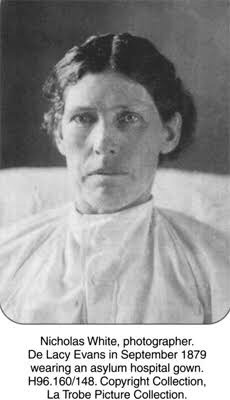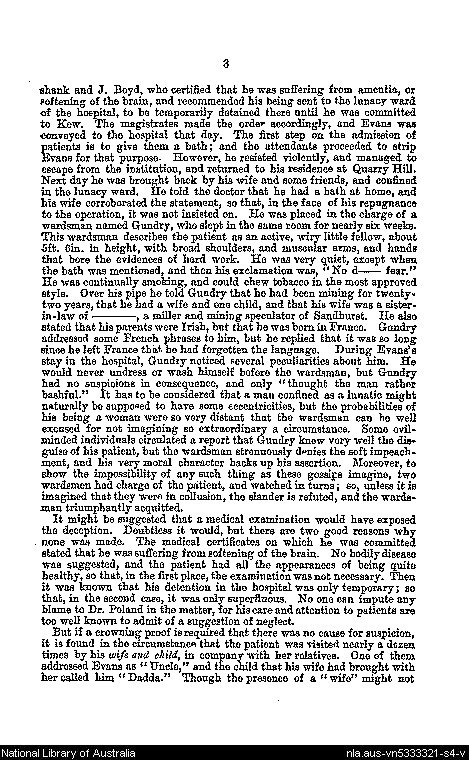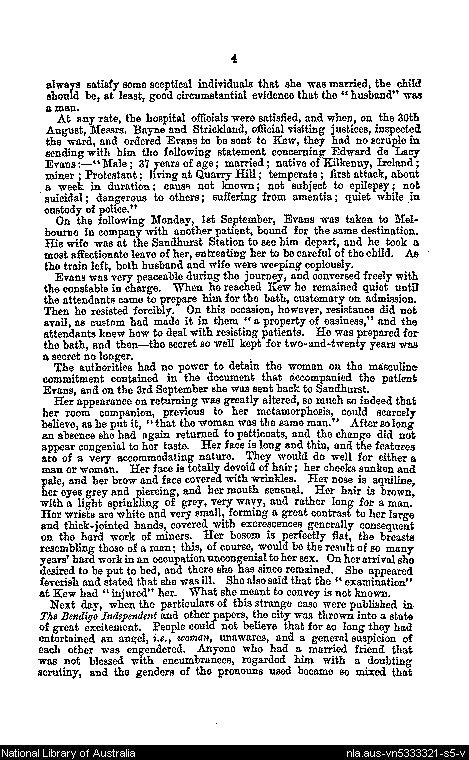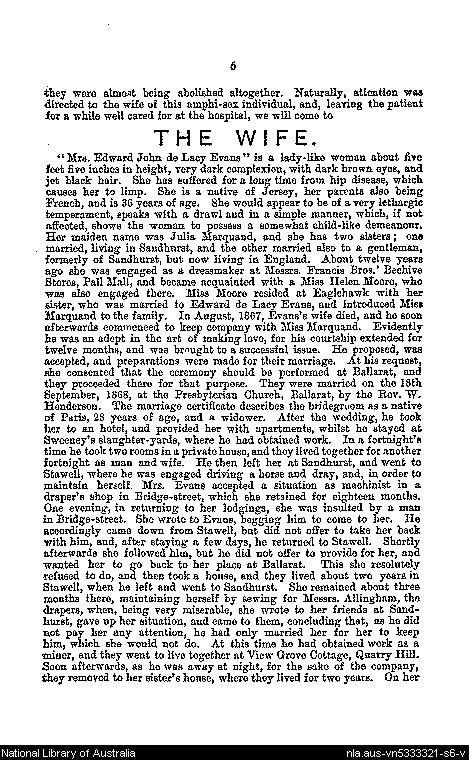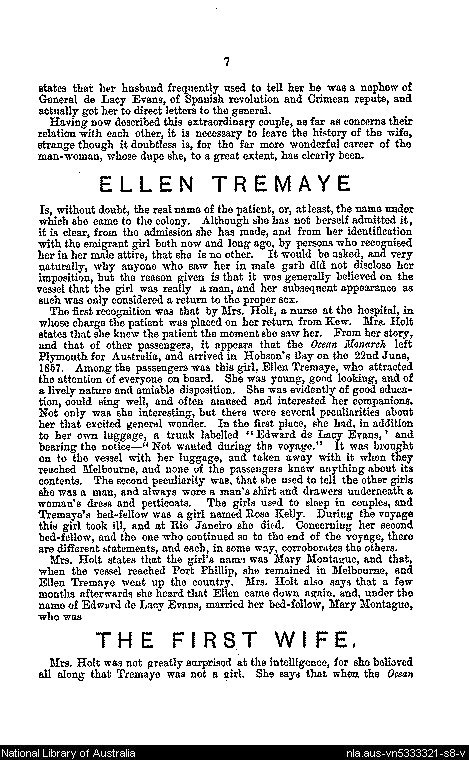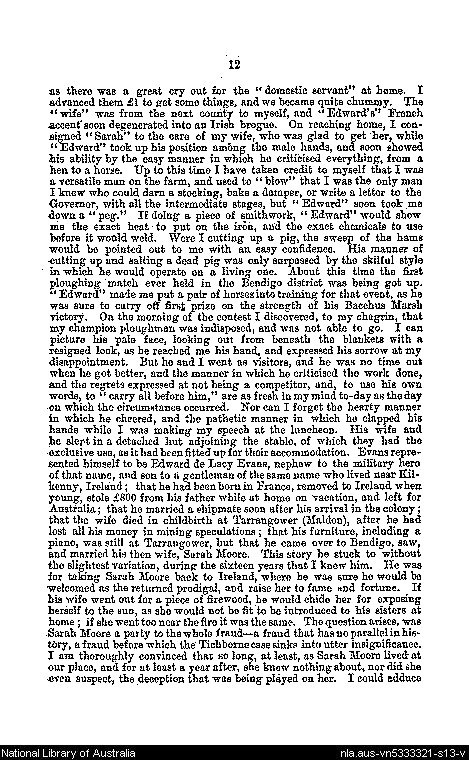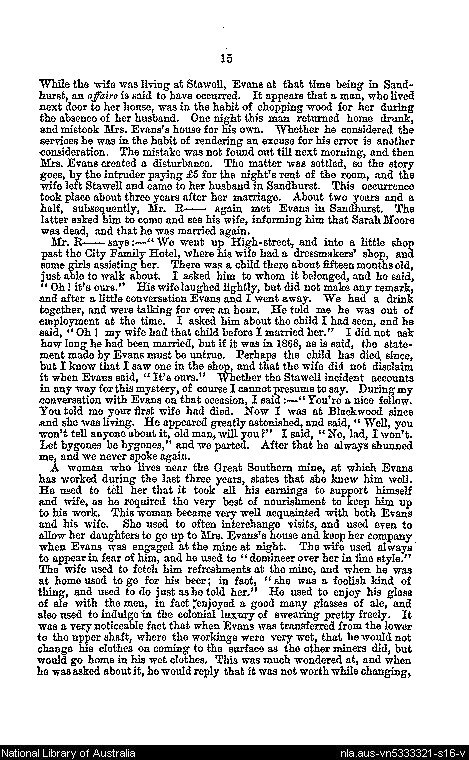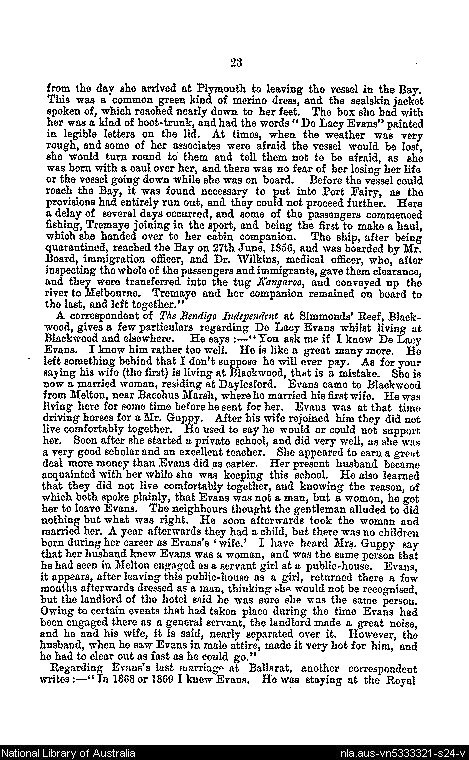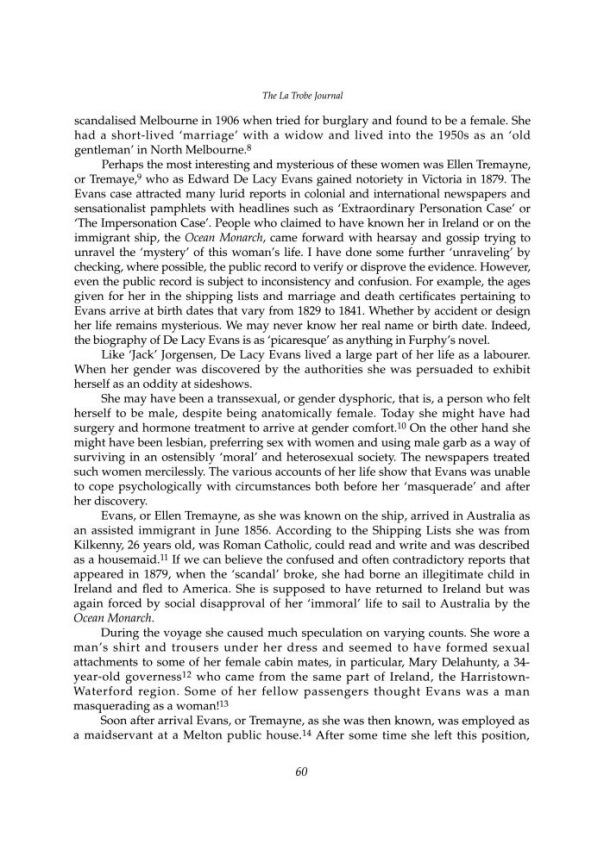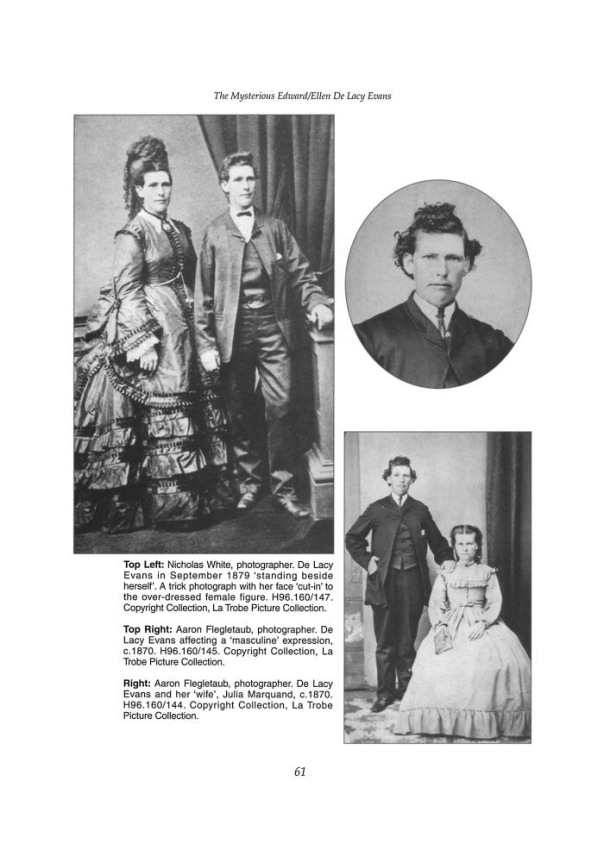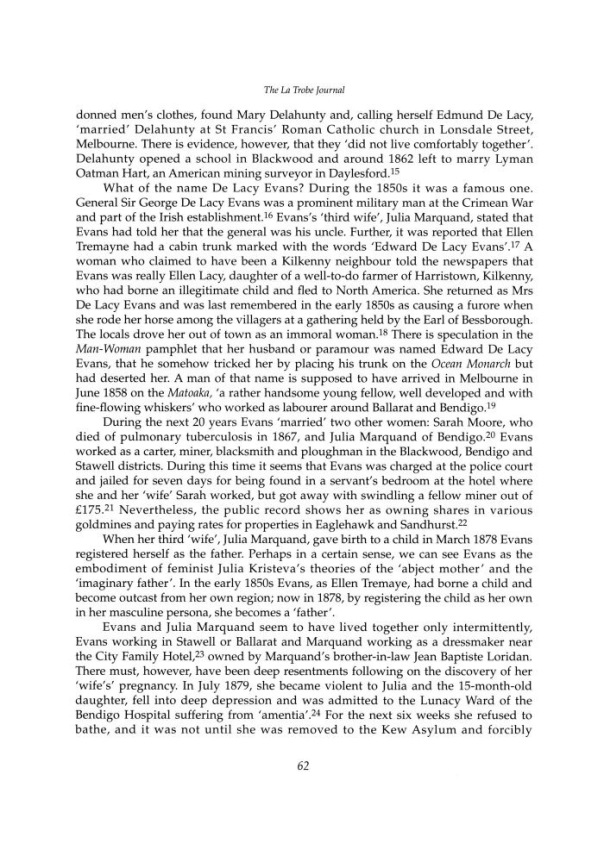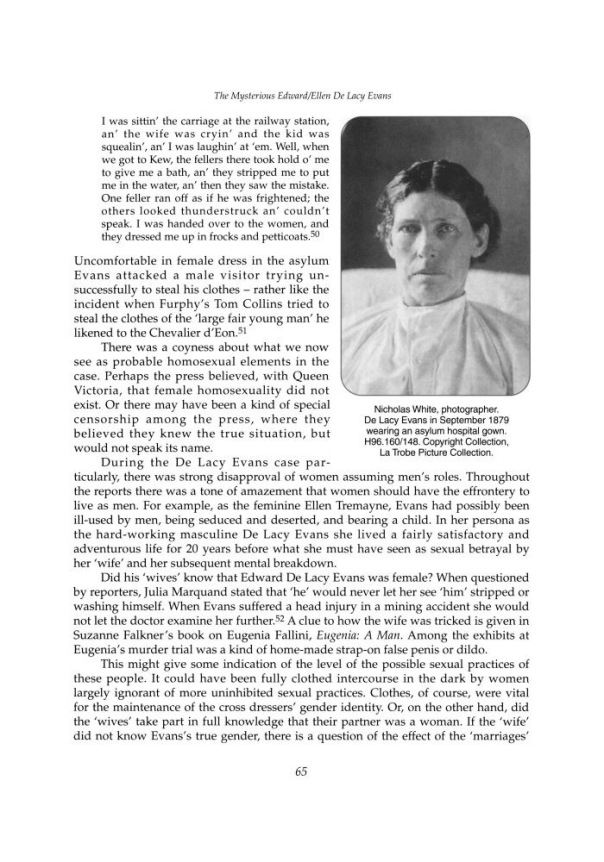Edward De Lacy Evans (born Ellen Tremayne or Tremaye, 1830? – 25 August 1901) was a servant, blacksmith and gold miner, who immigrated from Ireland to Australia in 1856, and made international news in 1879 when it was revealed he was a woman.
Early life and name
Mystery surrounds Evans’ early life and his choice of name.[1] He told miners he worked with in Australia that he was born in France, had stolen £500 as a boy and fled to Waterford, where he acquired his Irish accent.[2] A woman living near Corop, who claimed to be a former Kilkenny neighbour, said he was the well-born ‘Ellen Lacy’ who had an illegitimate child, fled to America, but returned in the early 1850s as ‘Mrs De Lacy Evans’ to ride her horse through a gathering called by John Ponsonby, 5th Earl of Bessborough before being ‘dragged off her pony’ and forced to ‘clear out’.[3] Evans’ third wife, Julia Marquand, said the name was a family one and his uncle was the well known British General George de Lacy Evans.[4]
After his hospitalisation, Evans said little about his past, and was described as ‘not disposed to be communicative'[3] and someone who ‘observes unusual taciturnity.’.[5] Asked why he had ‘impersonated a man’, he replied ‘Oh, it doesn’t matter, and the sooner they put me out of the way and get done with me the better.'[6]
In 1856, Evans arrived in Victoria, Australia, then in a goldrush ‘boom’ period, aboard the Ocean Monarch as part of the ‘assisted immigration scheme’ which aimed to provide the workers and residents needed in the growing colony.[1] Evans traveled under the name Ellen Tremayne and, in the information he provided, stated that he was aged 26, born in Kilkenny, was a Roman Catholic, a housemaid and could read and write.[1]
For most of the voyage to Australia, Evans wore the same outfit of ‘a green merino dress and sealskin coat reaching almost to her ankles’ with men’s shirt and trousers,[2] and was said to have a traveling trunk full of male attire, stamped with the name ‘Edward De Lacy Evans’.[7] This, and the fact he appeared to have ‘formed sexual attachments’ with some of the women he shared a cabin with, led to on-board speculation he was a man impersonating a woman.[1] One of these women was later identified as Rose Kelly who was said to have been taken ill and, as a result, departed at Rio de Janeiro en route,[8] while another was said to have been a Mary Montague.[7] Further speculation, from among his fellow passengers, was that the ‘real’ Edward De Lacy Evans had enticed ‘Ellen Tremayne’ to take passage with him on the ship by sending his trunk ahead but he then abandoned ‘her’.[2] A later theory, not publicly mentioned during the voyage or late 19th century newspaper reports, was that the clothes belonged to Evans, and he had been wearing them prior to his immigration, but decided to make the long sea voyage – either through fear of disclosure among men, or preferring the company of women – in a female guise.[2]

As a condition of his assisted passage Evans, under the name Ellen Tremayne, had been indentured as a maidservant to McKeddie, a Melton hotelkeeper, at a wage of 25 shillings per week, but he soon left the position and found one of his fellow passengers from the Ocean Monarch, Mary Delahunty.[1] Delahunty was a 34-year-old governess from Harristown, Waterford, in a similar area of Ireland to Evans, and another of the ‘close attachments’ he had made on the voyage.[1] Mrs. Thompson, a passenger on the Ocean Monarch, later said that Evans and Delahunty were from the same village in Kilkenny and that Delahunty was in possession of £900.[9] She also recalled Evans saying he would marry Delahunty ‘as soon as the ship reached Melbourne'[9] and, with Evans wearing male clothes, and calling himself ‘Edmund De Lacy’, the Roman Catholic ceremony took place at St Francis’ Church.[2]
Little is known of Evans and Delahunty’s married life over the next few years but there were reports that they ‘did not live comfortably together’.[1] Evans moved to work as a miner at Blackwood, in the state’s north-west, not far from Melton where he’d been employed as ‘Ellen Tremayne’, and Delahunty followed him in 1858.[10] Delahunty established a school in Blackwood but in 1862 left to marry Lyman Oatman Hart, an American mining surveyor.[1] Delahunty told ‘all who objected to this blatant act of bigamy’ that her first marriage was not legal as Evans was a woman.[10] Delahunty and Hart moved to Daylesford where they lived through the 1860s and 1870s.[10]
Sandhurst
Evans also left Blackwood in 1862, moving to the central Victorian city of ‘Sandhurst’ (now known as Bendigo), and, describing himself as a widower, he married a 23-year-old Irishwoman, Sarah Moore.[10] Over the next five years he held various occupations including carter, miner, blacksmith and ploughman[1] and lived with Moore in several nearby towns.[10] He also owned shares in a number of gold mines and paid property rates in Sandhurst and the adjoining district of Eaglehawk.[1] When he was found in a servant’s bedroom at a local hotel he was jailed for trespass for seven days.[1][2]
In 1867, Moore died of pulmonary tuberculosis[1] and the following year Evans met, and married, a friend of his former wife’s sister, 25-year-old Julia Marquand.[10] Marquand was a French dressmaker’s assistant who lived with her sister and brother-in-law, the prominent Sandhurst businessman, and owner of the ‘City Family Hotel’,[1] Jean Baptiste Loridan.[10]
In the early years of their marriage Evans and Marquand often lived apart but the couple reconciled by 1872.[4] Evans progressed in his mining profession and their Sandhurst home was a cottage that he had built.[4] A formal studio portrait taken at this time may be significant in its representation of how they saw themselves and their ‘establishment of a stable and traditional family unit’.[10]

In 1877, Marquand gave birth to a daughter the couple called ‘Julia Mary’.[11] Evans later supported Marquand when she brought a child maintenance suit against her brother-in-law Jean Baptiste Loridan for the child[12] but he gave his name as father on the birth certificate.[1] Around this period Evans’ was injured at work and, while he ‘welcomed the child as his own’ he was also ‘deeply disturbed by the circumstances in which his wife became pregnant’.[11]
On 21 July 1879, Loridan took him to the Bendigo Hospital[11] as he was ‘dangerous to others’,[13] but, when told to take a bath, he refused and escaped.[13] The following day he was arrested at home and brought to the Police Court where the magistrates agreed with the medical assessment that Evans was suffering from ‘softening of the brain’ and ordered him to be involuntarily committed to ‘the lunatic wards’ of the Bendigo hospital.[14]
‘A curious incident has occurred’ Edit
For six weeks at the Bendigo Hospital Evans refused to take a bath.[6] He shared a room with a warder called Gundry to whom he said that ‘his parents were Irish, but that he had come from France when about seven or eight years of age’.[6] However, when Gundry used some French phrases, Evans claimed that he’d ‘forgotten the language’.[6] While there he had regular visits from his wife and daughter, as well as other relatives, one of whom called Evans ‘Uncle’, while Julia Mary called him ‘Dadds’.[3]
On 30 August 1879, the hospital decided to send Evans and another patient to the Kew Asylum near Melbourne, accompanied by a police constable.[6] Marquand was at the station and Evans told her to care of Julia Mary and ‘both he and his wife were weeping’ by the time they left.[6]

The events at the Kew Asylum were described in The Argus on 3 September 1879:
“A curious incident has occurred at Kew Lunatic Asylum. A lunatic was brought from Sandhurst by the police, and was admitted into one of the male wards. The patient was tolerably quiet until preparations were made for giving ‘him’ the usual bath. On the attendants attempting to carry out the programme, violent resistance was made, the reason for which proved to be that the supposed man was in reality a woman. The most singular part of the affair is that the woman had been received into Sandhurst Hospital as a male patient and sent thence to the asylum under the name of Evans. She states that she has lived at Sandhurst for many years dressed in male attire. Her age is about 35.”[15]
On 4 September 1879, the Bendigo Advertiser ran with the headline ‘Extraordinary Case Of Concealment Of Sex’ and wrote:
“One of the most unparalleled impostures has been brought to light during the past few days, which it has ever been the province of the press of these colonies to chronicle, and we might even add is unprecedented in the annals of the whole world. A woman, under the name of Edward De Lacy Evans, has for 20 years passed for a man in various parts of the colony of Victoria… As it is almost impossible to give an account of the case without making use of the masculine pronoun when referring to Evans, we propose to use that appellation… “[6]
It was soon reported by local newspapers, and then the ‘colonial and international press’, that Evans had been determined by the Kew Asylum to be a woman, and ‘promptly handed over to female nurses’ and sent back in Bendigo.[1] Evans later recalled:
“The fellers there took hold o’ me to give me a bath, an’ they stripped me to put me in the water, an’ then they saw the mistake. One feller ran off as if he was frightened; the others looked thunderstruck an’ couldn’t speak. I was handed over to the women, and they dressed me up in frocks and petticoats.”[16]
While still a patient at Bendigo, Evans said he knew who the father of his child was, made a reference to his wife not being ‘true’, and mentioned concerns about financial difficulties and possibly losing the house he had built, before adding, ‘Everything coming together was enough to drive a man mad.'[3] Marquand also spoke to the press and insisted she had never known Evans was not a man.[4]
It wasn’t only the newspapers that covered the ‘curious incident’; Stawell photographer Aaron Flegeltaub began selling copies of the formal portrait Marquand and Evans had taken in the early 1870s, while Sandhurst photographer N. White managed to gain access to the Bendigo Hospital and took a number of head-shots of Evans wearing a ‘white hospital nightshirt (or straight-jacket)’ and looking ‘wild eyed and probably affronted by the intrusion’ which were used to create an image he also sold.[1] The hospital refused requests from ‘entrepreneurs’ for Evans be ‘publicly exhibited’.[1]
‘Another intrusion’ was a gynaecological examination conducted by a Dr Penfold, which caused Evans to ‘cry and scream’ when the speculum was used, and resulted in a finding that he was ‘physiologically female’ and ‘had carried and borne a child’.[1] Evans later said the ‘examination had injured’ him.[3]
On 10 October 1879, the Bendigo Hospital declined a request by the Kew Asylum to return Evans as he ‘was improving daily, and will soon be in a fit state to be discharged’.[17] By December, Evans was declared ‘cured’ and released,[11] but, a few days later, dressed in female clothes, he was ‘still mentally distressed’ when he gave evidence in support of Marquand’s unsuccessful suit against Loridan.[1][18]
Later life and legacy
In late December 1879, Evans was part of events by ‘panorama showmen’ Augustus Baker Pierce and William Bignell in Geelong and Stawell and newspapers noted that ‘neither mind nor body possesses the vigour once so noticeable’.[1] This was followed, in 1880, by appearances in Melbourne billed as ‘The Wonderful Male Impersonator’ as part of the ‘living wonders’ at the Waxworks,[19] while Sydney shows were accompanied by pamphlets about ‘The Man-Woman Mystery’.[3]
By February 1881, Evans had applied for admittance to a Benevolent Asylum and he was sent to the Melbourne Immigrants’ Home in St Kilda Road.[1] He remained there until his death, twenty years later, on 25 August 1901.[20]
In 1897, Joseph Furphy, who, from the late 1860s, lived near Bendigo, published his first novel Such Is Life and included the comparison to Evans with the mention; ‘one of those De Lacy Evanses we often read of in novels’.[1]
In 2006, sites associated with Evans were included in the history walk presented as part of Melbourne’s Midsumma Festival.[21]
References
- Colligan, Mimi (Autumn 2002). “The Mysterious Edward/Ellen De Lacy Evans: The Picaresque in Real Life”. The La Trobe Journal (69). Retrieved 2013-10-03.
- Lucy Sarah Chesser (2008). Parting with My Sex: Cross-dressing, Inversion and Sexuality in Australian Cultural Life. Sydney University Press. p. 10. ISBN 978-1-920898-31-1.
- Unknown (1880). The History and confession of Ellen Tremaye, alias, De Lacy Evans, the man-woman. Melbourne: Wm. Marshall. p. 27. Retrieved 2013-10-03.
- “INTERVIEW WITH MRS. EVANS.”. Bendigo Advertiser (Vic.: National Library of Australia). 4 September 1879. p. 2. Retrieved 3 October 2013.
- “THE SANDHURST IMPERSONATOR— EDWARD DE LACY EVANS.”. Illustrated Australian News (Melbourne: National Library of Australia). 1 October 1879. p. 155. Retrieved 4 October 2013.
- “EXTRAORDINARY CASE OF CONCEALMENT OF SEX.”. Bendigo Advertiser (Vic.: National Library of Australia). 4 September 1879. p. 2. Retrieved 3 October 2013.
- “FURTHER PARTICULARS.”. Bendigo Advertiser (Vic.: National Library of Australia). 5 September 1879. p. 1 Supplement: Supplement to The Bendigo Advertiser. Retrieved 4 October 2013.
- “Ellen Tremaye, alias Edward De Lacy Evans, the Female Impersonator.”. Australian Town and Country Journal (NSW: National Library of Australia). 11 October 1879. p. 32. Retrieved 4 October 2013.
- “Ellen Tremaye, alias Edward De Lacy Evans, the Female Impersonator.”. Australian Town and Country Journal (NSW: National Library of Australia). 11 October 1879. p. 32. Retrieved 4 October 2013.
- Lucy Sarah Chesser (2008). Parting with My Sex: Cross-dressing, Inversion and Sexuality in Australian Cultural Life. Sydney University Press. p. 11. ISBN 978-1-920898-31-1.
- Lucy Sarah Chesser (2008). Parting with My Sex: Cross-dressing, Inversion and Sexuality in Australian Cultural Life. Sydney University Press. p. 13. ISBN 978-1-920898-31-1.
- Lucy Sarah Chesser (2008). Parting with My Sex: Cross-dressing, Inversion and Sexuality in Australian Cultural Life. Sydney University Press. p. 16. ISBN 978-1-920898-31-1.
- “The Female Impersonator.”. The Northern Territory Times and Gazette (National Library of Australia). 15 November 1879. p. 2. Retrieved 4 October 2013.
- “CROSS PURPOSES.”. Bendigo Advertiser (Vic.: National Library of Australia). 23 July 1879. p. 2. Retrieved 3 October 2013.
- “Victoria.”. The Evening News (Sydney: National Library of Australia). 3 September 1879. p. 2. Retrieved 3 October 2013.
- Pryor, Lisa (2012-08-04). “Born as a girl”. Daily Life (Fairfax). Retrieved 2013-10-03.
- “SANDHURST.”. The Argus (Melbourne: National Library of Australia). 10 October 1879. p. 3. Retrieved 4 October 2013.
- “Victoria.”. The Evening News (Sydney: National Library of Australia). 6 December 1879. p. 5. Retrieved 4 October 2013.
- “DEATH OF DE LACY EVANS.”. The Argus (Melbourne: National Library of Australia). 27 August 1901. p. 5. Retrieved 4 October 2013.
- “MAN IMPERSONATORS.”. Queanbeyan Age (Queanbeyan, NSW: National Library of Australia). 23 November 1906. p. 4. Retrieved 4 October 2013.
- Hunter, Tim (2006-01-26). “The queer streets of Bearbrass”. The Age. Retrieved 2013-10-03.
External links
- Pamphlet sold at Sydney ‘shows’: The History and confession of Ellen Tremaye, alias, De Lacy Evans, the man-woman (1880)
Daily Mail Australia – 14 August 2014
By Louise Cheer for Daily Mail Australia
Was this Irish maid Australia’s first transgender person? Ellen Tremayne was leading a double life as Edward De Lacy Evans in 19th century Victoria
- For about 20 years of his life, Edward De Lacy Evans lived as a man
- He was born in Ireland as Ellen Tremayne and died in 1901 in Melbourne
- Mr De Lacy Evans was married three times and was ‘father’ to one daughter
- He worked as a carter, miner, blacksmith and ploughman across Victoria
The story of Edward De Lacy Evans read like every other man’s in the 19th century – he was a labourer, husband and father.
But underneath the suit and tie was a body of a woman named Ellen Tremayne – also known as Ellen Tremaye – who could have been Australia’s first transgender person.
Mr De Lacy Evans arrived on Australian shores from Ireland in June 1856 as an assisted immigrant on-board the Ocean Monarch.
It is speculated he was born between 1829 to 1841 due to a discrepancy in shipping lists, and birth, marriage and death certificates.

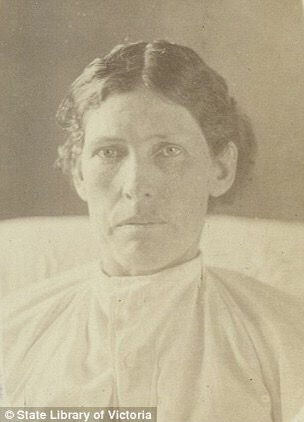

According to ship records, he was a 26-year-old Roman Catholic from Kilkenny who could read and write, and was listed as a housemaid.
When she arrived in Victoria, Mr De Lacy Evans was still known as Ellen Tremayne and caused quite a stir on the trip over.
According to the State Library of Victoria’s The La Trobe Journal, he wore a man’s shirt and trousers underneath his dress and had formed sexual attachments to some of the other female passengers on the Ocean Monarch, including his soon-to-be first wife, Mary Delahunty – a 34-year-old governess who was also from Ireland.
He travelled with a trunk labelled with the name ‘Edward De Lacy Evans’ on it who, according to De Lacy Evans’ third wife, was his uncle.
There was also speculation her husband or lover was named ‘Edward De Lacy Evans’ and he had somehow tricked the transsexual by placing his trunk on the Ocean Monarch and deserted the 26-year-old.
Mr De Lacy Evans’, who was still identified as a woman, first job in Australia was as a maidservant at a Melton public house but some time after he left his position and started dressing like a man, and ditched the name of Ellen Tremayne.


Now as Edmund De Lacy, he went and sought out Ms Delahunty, marrying her at St Francis’ Roman Catholic Church in Lonsdale Street, Melbourne.
But their marriage was not a happy one, with evidence suggesting they ‘did not live comfortably together’.
After Ms Delahunty opened a school in Blackwood, she left Mr De Lacy Evans and married an American mining surveyor Lyman Oatman Hart who lived in Daylesford – north-west of Melbourne.
In the next 20 years, Mr De Lacy Evans married twice – his second wife was Sarah Moore who died of pulmonary tuberculosis in 1867 and a Julia Marquand of Bendigo – north of Melbourne.
Mr De Lacy Evans worked as a carter, miner, blacksmith and ploughman in the areas of Blackwood, Bendigo and Stawell.
The breakdown of his third marriage came after March 1878 when Ms Marquand gave birth to a child fathered by her brother-in-law, Jean Baptiste Loridan.
Despite Mr De Lacy Evans knowing it was not his child, he registered himself as the child’s father but his resentment over the pregnancy started taking its toll on the marriage.
In July 1879, he started violently acting out against Ms Marquand and his 15-month-old daughter, fell into a deep depression and then was admitted to Bendigo Hospital’s lunacy ward for amentia – a mental disability.

For the first six weeks of his stint in the hospital, Mr De Lacy Evans refused to bathe until he was transferred to the Kew Asylum and forcibly stripped that his secret was discovered.
He was handed over to female nurses and forced to dress as a woman
In an interview, Mr De Lacy Evans’ recalled the moment he was outed as a female at Kew Asylum.
‘I was sittin’ the carriage at the railway station, an’ the wife was cryin’ and the kid was squealin’, an’ I was laughin’ at ‘em,’ he said during an interview.
‘Well, when we got to Kew, the fellers there took hold o’ me to give me a bath, an’ they stripped me to put me in the water, an’ then they saw the mistake.
‘One feller ran off as if he was frightened; the others looked thunderstruck an’ couldn’t speak.
‘I was handed over to the women, and they dressed me up in frocks and petticoats.’
Mr De Lacy Evans’ outing as a female caused a worldwide stir, with one photographer named Nicholas White sneaking into the hospital and taking photos of the transsexual dressed as a man and a woman as well as possibly a straitjacket.
As a transgender person, Mr De Lacy Evans’ faced brutal treatment inside the asylum including a report done up by The Australian Medical Journal that said he cried and screamed as he was probed during a gynaecological examination – which verified he was a physiologically a woman.
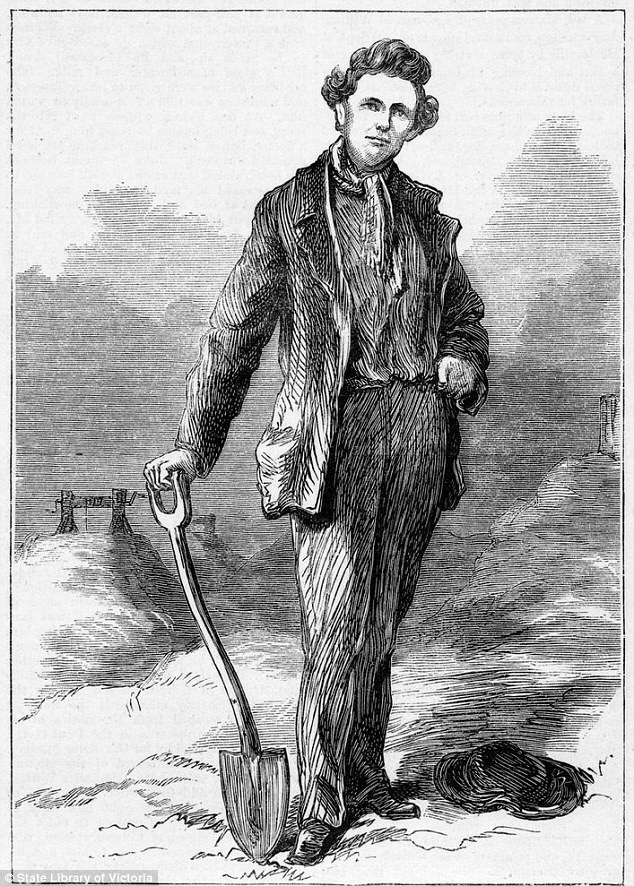
With the news in circulation, Mr De Lacy Evans received offers to be ‘publicly exhibited’ and after his release from Kew Asylum he took up the opportunities. He was once offered three to five pounds per week for a tour.
He appeared as ‘The Wonderful Male Impersonator’ at St Georges Hall on Bourke Street in Melbourne in January 1880 and another time alongside a trapeze artist and ‘The Electric Boy’ at Sydney’s Egyptian Hall on George Street in September 1880.
When the truth came out his wife, Ms Marquand denied knowing her husband was in fact a woman and accounted for her daughter’s existence by telling reporters: ‘Some strange man entered the house one night about the time her husband should have returned home’.
Ms Marquand also stated her husband would never let her see him stripped or washing himself.
Additionally, Mr De Lacy Evans could have fooled his wife into thinking he was a man by fashioning a homemade strap-on dildo.
There was also evidence Mr De Lacy Evans’ second wife, Sarah Moore, found out about her husband’s cross-dressing about a year into their marriage
A witness reported seeing Ms Moore punching Mr De Lacy Evans in the breast – her ‘weak place’.
Mr De Lacy Evans lived as a man for another 25 years and found no success in show business.
In February 1881, he was applying for relief at the Melbourne Police Court and wanted to be admission to the Benevolent Asylum.
Mr De Lacy Evans died in August 1901 in the Melbourne Immigrants’ Home at St Kilda Road, where he had been since February 1881.
Read more:
The Mysterious Edward/Ellen De Lacy Evans: The Picaresque in Real Life – No 69 Autumn 2002 – La Trobe Journal
Read more: http://www.dailymail.co.uk/news/article-2726564/Was-Irish-maid-Australias-transgender-person.html#ixzz3y3uiLcvB
Follow us: @MailOnline on Twitter | DailyMail on Facebook
From La Trobe Journal
No 69 Autumn 2002



